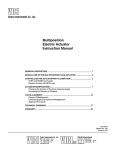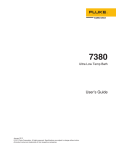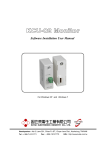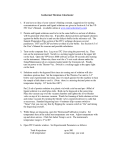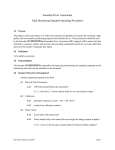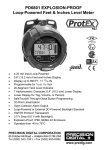Download 597357-7359 manual
Transcript
Harvard Liquid Switch User’s Manual Harvard Liquid Switch 55-3438 Table of Contents Harvard Apparatus ‘Liquid Switch’ Manual 1 SUBJECT PAGE NO. Table of Contents ..........................................................................................................1 General Information - Warranty and Repairs ................................................................2 Cleaning and Rotor Replacement Instructions ..........................................................3-5 Disassembly - Valves with External Spring Hardware ....................................................3 Disassembly - Valves with Preload Assembly..................................................................4 Cleaning ........................................................................................................................5 Assembly and Alignment Procedure (New or Used Rotor) ......................................6-10 Leak Detection ............................................................................................................11 Flow Chart Illustration ................................................................................................12 General Information Harvard Apparatus ‘Liquid Switch’ Manual 2 Serial Numbers All inquires concerning our product should refer to the serial number of the unit. Serial numbers are located on the rear of the chassis. Calibrations All electrical apparatus is calibrated at rated voltage and frequency. While the flow will stay calibrated, the peak will vary. Warranty Harvard Apparatus warranties this instrument for a period of one year from date of purchase. At its option, Harvard Apparatus will repair or replace the unit if it is found to be defective as to workmanship or material. This warranty does not extend to damage resulting from misuse, neglect or abuse, normal wear and tear, or accident. This warranty extends only to the original customer purchaser. IN NO EVENT SHALL HARVARD APPARATUS BE LIABLE FOR INCIDENTAL OR CONSEQUENTIAL DAMAGES. Some states do not allow exclusion or limitation of incidental or consequential damages so the above limitation or exclusion may not apply to you. THERE ARE NO IMPLIED WARRANTIES OF MERCHANTABILITY, OR FITNESS FOR A PARTICULAR USE, OR OF ANY OTHER NATURE. Some states do not allow this limitation on an implied warranty, so the above limitation may not apply to you. If a defect arises within the one-year warranty period, promptly contact Harvard Apparatus, Inc. 84 October Hill Road, Building 7, Holliston, Massachusetts 01746-1371 using our toll free number 1-800-272-2775. Goods will not be accepted for return unless an RMA (returned materials authorization) number has been issued by our customer service department.The customer is responsible for shipping charges. Please allow a reasonable period of time for completion of repairs, replacement and return. If the unit is replaced, the replacement unit is covered only for the remainder of the original warranty period dating from the purchase of the original device. This warranty gives you specific rights, and you may also have other rights which vary from state to state. Repair Facilities and Parts Harvard Apparatus stocks replacement and repair parts. When ordering, please describe parts as completely as possible, preferably using our part numbers. If practical, enclose a sample or drawing.We offer a complete reconditioning service. CAUTION This pump is not registered with the FDA and is not for clinical use on human patients. Cleaning & Rotor Replacement Instructions Harvard Apparatus ‘Liquid Switch’ Manual 3 Perform all other system checks before working on the valve. Since any contact between the interior of the valve body and the metal of the rotor is likely to cause damage, do not take the valve apart unless the system malfunction is definitely isolated to the valve. If disassembly is absolutely necessary, make certain to carefully observe the instructions listed below for disassembly, cleaning and reassembly. Disassembly - Valves with External Spring Hardware Perform all disassembly operations in a clean, well-lighted area. Flush all hazardous or toxic materials from the valve before starting. 1. For a valve on a standoff: Use a 7/64 hex driver to loosen the 6-32 x 5/8" socket head screw in the clamp ring which holds the valve to the standoff tube (not the one which holds the standoff to the actuator) and remove the valve from the actuator/standoff assembly. For a closemount valve: Use a 7/64 hex driver to loosen the 6-32 x 5/8" socket head screw in the clamp ring between the valve and the actuator, and remove the valve from the actuator. 2. Using a 7/16" open wrench or nut-driver, loosen and remove the 10-32 hex nuts from the threaded seal shaft. 3. Slide the coil spring and washers from the shaft, taking care to note their order for reassembly later. 4. Grasp the valve firmly and give a slight rotation to the 1/4" shaft of the rotor to break apart the sealing surfaces. Alternatively, grip the valve with the 1/4" shaft pressed firmly into the palm of the hand to restrict its travel and tap the end of the threaded shaft. 5. After the sealing surfaces are broken free in the above operation, carefully pull the rotor out of the tapered interior of the valve body. Cleaning & Rotor Replacement Instructions Harvard Apparatus ‘Liquid Switch’ Manual 4 Disassembly - Valves with Preload Assembly Perform all disassembly operations in a clean, well-lighted area. Flush all hazardous or toxic materials from the valve before starting. 1. Unscrew the preload assembly from the valve. For valves rated at pressures over 1000 psi, it is helpful to unscrew the preload 1/2 turn before trying to unscrew the preload itself. (Figure 1) 2. Engage the end of the rotor (Figure 2) with a pencil-type magnet. 3. Step the actuator through several positions to break apart the sealing surfaces and carefully withdraw the rotor form the valve body with the magnet. 4. For a valve on a standoff: Use a 7/64 hex driver to loosen the 6-32 x 5/8" socket head screw in the clamp ring which holds the valve to the standoff tube (not the one which holds the standoff to the actuator) and remove the valve from the actuator/standoff assembly. For a closemount valve: Use a 7/64 hex driver to loosen the 6-32 x 5/8" socket head screw in the clamp ring between the valve and the actuator, and remove the valve from the actuator. Valve Body Preload Assembly End of Rotor Socket Adjustment Screw Cleaning & Rotor Replacement Instructions Harvard Apparatus ‘Liquid Switch’ Manual 5 Cleaning 1. Using clean dry air, blow any loose debris from the valve body and the rotor. 2. Using a strong solvent and an optical quality lint-free wiper such as a Kimwipe, wipe away any loosely bound seal material which may have worn free and adhered to either surface. Avoid using halocarbon solvents if the valve is to be used in a system with electron capture detection, since some of the solvents may persist at the trace level. Be sure to consult the Manufacturer’s Data Safety sheet for whatever solvent is utilized. Note: If the valve has been used with aqueous buffer solutions and some leakage has occurred, wipe the sealing surfaces of the valve with a water-moistened Kimwipe before using a nonpolar solvent to clean any seal material still adhering to the valve’s interior. 3. Visually inspect the interior of the valve body.The conical surface should appear uniform as well as highly polished. If any scratches are visible between the ports or anywhere else, suggesting a potential leakage path or wear source, the valve should be returned to the factory for regrinding. If the rotor’s sealing surface shows any scratches and/or a narrowing of the surface flow passages, replacement is necessary. If the valve body interior is in good condition, a field replacement of the rotor may be effected using the following procedure. Assembly & Alignment Procedure (New or Used Rotor) Harvard Apparatus ‘Liquid Switch’ Manual 6 The valve will have either one (SD and SC types) or two (SF and ST types) rows of ports evenly spaced around the circumference of the body. See Figure 4. In addition there will be one (SD and SF types) or two (SC and ST types) “common” ports offset to either side of these rows.The rotor will have either one or two flow passage(s) appearing as engraved rings around the seal, which intersect the common port(s). Flow passage(s) perpendicular to the rings(s) connect the ring(s) to the selected port(s). STUW The only configuration which does not fall within this description is the STUW. Unlike the standard ST, these have one row of port around the circumference, with two common ports offset in the same direction. The common ports are 180° apart, so only one shows in Figure 4. Special instructions and descriptions regarding STUW and/or SDUW valves will be highlighted in this manner at several points in the procedures below. The alignment procedure is a way of centering the perpendicular engraving on the selected port by determining the point at which flow begins (when the engraving is just beginning to intersect the port) and the point at which flow ends (when the engraving has ceased to intersect the port), and centering the rotor between those two points. 1. Make sure that all sealing surfaces are clean and dry. 2. If a used rotor is to be reinstalled, clean with a light solvent and blow the passages clean with compressed air. Discard the rotor if any scratches are visible between ports. 3. Locate the common port offset toward the small end of the valve interior. (In SD and SC valves this is the only common port).This port, called the alignment inlet, will be the designated inlet throughout this procedure. STUW In the case of the STUW with both common ports at the same end, either will serve the current purpose. 4. Put a nut in the port corresponding to the last or highest numbered position: For an electric actuator: With the valve oriented as in Figure 4, the nut goes in the port above the alignment inlet. For an air actuator: With the valve oriented as in Figure 4, the nut goes in the port below the alignment inlet. 5. Locate the flow passages(s) perpendicular to the ring(s) that go around the rotor. Note the pin which passes through the shaft.The end of the pin on the same side of the rotor as the flow passages(s) perpendicular to the rings will be used as a pointer. (Figure 4) Assembly & Alignment Procedure (New or Used Rotor) Harvard Apparatus ‘Liquid Switch’ Manual 7 STUW, SDUW The pointer will be that end of the tab which is stamped “P”,“H” or “E”, denoting the valve series. (Fig. 3) POINTER Figure 3 6. Insert the rotor in the valve body with the pointer centered on the nut, being careful not to touch the polished interior surface of the valve body with any of the metal parts of the rotor. 7. Slide the three washers (in this sequence: 3/4" OD washer,Teflon or polyimide washer, standard 1/2" OD stainless steel washer) over the 3/16" diameter threaded shaft while holding the rotor pressed firmly into the valve body.The flat side of the 3/4" back washer should rest on the rear collar of the valve. Next put the spring and the stainless hex nut in place.Tighten the nut 1/2 turn beyond finger tight and butt the elastic lock nut against it. Assembly & Alignment Procedure (New or Used Rotor) Harvard Apparatus ‘Liquid Switch’ Manual 8 STUW, SDUW Simply screw the preload on until the threads bottom out. 8. For an electric actuator, plug the actuator in. If the position indicator doesn’t read “1”, flip the switch to the HOME position. For an air actuator, determine that the actuator is in Position 1, but then if necessary override or disable the means of pulsing the air to the actuator so that pressure is continuously applied to the actuator port nearest the valve. 9. Place the valve on the actuator/standoff. By convention, the factory alignment places the common port(s) at 12 o’clock. Re-orienting the standoff or the slotted coupling (in closemount applications) on the square drive of the actuator allows three other possibilities. STUW Either common port may be at 12 o’clock For a closemount valve, make sure that the ends of the pin in the rotor are engaged by the slots of the coupling. Tighten the screw in the clamp ring enough to keep the valve from falling out when it is released, but make sure it is loose enough to allow the valve to be turned during the alignment procedure. For a valve on a standoff, make sure that the ends of the pin in the rotor are engaged by the slots of the standoff drive shaft, and tighten the clamp ring screw. Loosen the screw in the clamp ring which holds the standoff to the actuator enough to allow the valve/standoff assembly to be turned during the alignment procedure. 10. Establish a flow of clean gas (50 psi is adequate) into the alignment inlet. STUW Establish gas flow into the common port at 6 o’clock (alignment inlet in Figure 4). NOTE:When listening for flow in the following steps, it is helpful if the fittings are removed from the port under consideration but left in the adjacent ports. If all the fittings have been removed, install a loop connecting the two ports adjacent to the target port to better isolate the sound of the flow. CAUTION: Up to this point the instructions have been applied to both air and electrically actuated valves. Because the two types of actuators rotate in opposite directions, it is necessary for the instructions to diverge at this point. For an electrically actuated valve, proceed with the steps on the next page. For an air actuated valve, proceed with the steps on page 10. Assembly & Alignment Procedure (New or Used Rotor) Harvard Apparatus ‘Liquid Switch’ Manual 9 For an electrically actuated valve, continue with this step 11. 11. With the valve facing you and the actuator behind the valve, the port to the left of or counterclockwise form the alignment inlet corresponds to Position 1. STUW With the common port at 6 o’clock as the inlet, the port to the left of or counterclockwise from the common port at 12 o’clock corresponds to Position 1. If the assembly was done properly in Step 5, air will be coming out of the port to the right of the alignment inlet (or common port at 12 o’clock for STUW’s). If so, proceed to Step 12. If the initial alignment was off a little, grip the valve and rotate it slightly in either direction (the actuator keeps the rotor fixed) until gas flows from this port.This sets up the “staging area” for the approach to Position 1. 12. Grip the valve and slowly rotate it clockwise until the first traces of flow are heard from the port of Position 1. 13. While holding the valve steady, use a soft pencil or ink marker to make a mark on the valve body or standoff corresponding to the slot in the actuator clamp ring.This slot makes a clear reference point for observing relative rotational positions. (Figure 5) 14. Continue the slow manual clockwise rotation of the valve body through the point of peak flow and on until the flow stops or is barely perceptible, as in Step 12. First mark (step 13) Third mark (step 16) Second mark (step 15) Figure 5: Marking valve or standoff during alignment procedure; electrically actuated 15. Make another mark as in Step 13. (Figure 5) 16. Make a third pencil mark centered between the first two and rotate the valve counterclockwise until this midway mark is reached. 17. Wile holding the valve steady, firmly tighten the screw in the clamp ring.The rotor should be properly positioned at the point of maximum flow where the actuator is stepped to the next position. Assembly & Alignment Procedure (New or Used Rotor) Harvard Apparatus ‘Liquid Switch’ Manual 10 For an air actuated valve, continue with this step 11. 11. With the valve facing you and the actuator behind the valve, the port to the right of or clockwise from the alignment inlet corresponds to Position 1. STUW With the common port at 6 o’clock as the inlet, the port to the right of or clockwise from the common port at 12 o’clock corresponds to Position 1. If the assembly was done properly in Step 5, air will be coming out of the port to the left of the alignment inlet (or common port at 12 o’clock for STUW’s). If so, proceed to Step 12. If it is not, grip the valve and rotate it counterclockwise until gas flows from this port. Depending on which way the initial alignment was off, this will take either a very slight rotation or nearly a full revolution. (Even though flow might have been achieved by a slight clockwise rotation, the air actuator will not keep the rotor fixed against a force in that direction. ) This sets up the “staging area” for the approach to Position 1. 12. Grip the valve and rotate it counterclockwise until the first traces of flow are heard from the port of Position 1. 13. While holding the valve steady, use a soft pencil or ink maker to make a mark on the valve body or standoff corresponding to the slot in the actuator clamp ring.This slot makes a clear fixed reference point for observing relative rotational positions. (Figure 6) 14. Continue the slow manual counterclockwise rotation of the valve body through the point of peak flow and on until the flow stops or is barely perceptible, as in Step 12. 15. Make another mark as in Step 13. (Figure 6) 16. Make a third pencil mark centered between the first two and rotate the valve clockwise until this midway mark is reached. (Figure 6) 17. While holding the valve steady, firmly tighten the screw in the clamp ring.The rotor should be properly positioned at the point of maximum flow when the actuator is stepped to the next position. First mark (step 13) Third mark (step 16) Second mark (step 15) Figure 6: Marking valve or standoff during alignment procedure; air actuated It is a good idea to cycle the valve through all its positions to be certain everything is functioning properly. In some cases it is possible to do an additional alignment check by simply looking down the fitting detail and into the port as the valve is stepped from position to position. If it is a valve which has a relatively short distance from the bottom of the detail to the internal taper, the engraved “dimples” on the seal are visible as they come into alignment with the port. Leak Detection Harvard Apparatus ‘Liquid Switch’ Manual 11 The assembly instructions above put a minimum amount of tension on the spring to facilitate the manual adjustments required in the alignment procedure. Before proceeding with this section, add an additional full turn to the hex nuts on the rotor shaft and cycle the valve through a complete revolution. STUW, SDUW If the preload socket adjustment screw was unscrewed 1/2 turn in Disassembly Step 1, use the spot of paint as a guide to return it to its original position. 1. The valve may be tested with a gas leak detector. If a leak detector is unavailable, the valve may be pressurized with an appropriate gas and immersed in a solvent with low surface tension, e.g. 2-propanol. Be careful to test for gross leaks before immersing the valve. Wear eye protection. 2. If the valve leaks, tighten the nuts in 1/4 turn increments, cycling the valve through a complete revolution between each 1/4 turn of tension, until leaking stops. Test after each additional 1/4 turn. Never tighten the spring to the point where its windings touch one another. STUW, SDUW If the valve leaks, tighten the socket adjustment screw in increments of approximately 1/16 turn, cycling the valve through a complete revolution between each increment. Test after each additional 1/16 turn. Flow Chart Harvard Apparatus ‘Liquid Switch’ Manual 12 Syringe Pump 4 position SC Valve Sample Inlets Drain (common) One Sample Out 1 2 3 4














